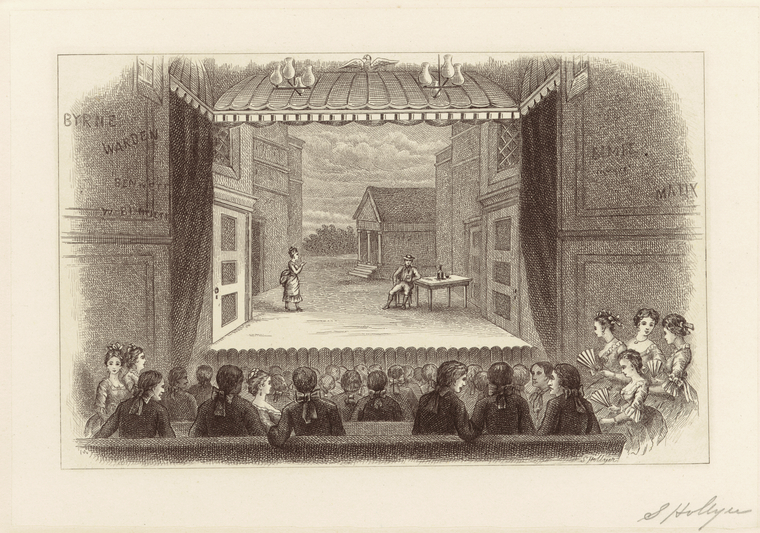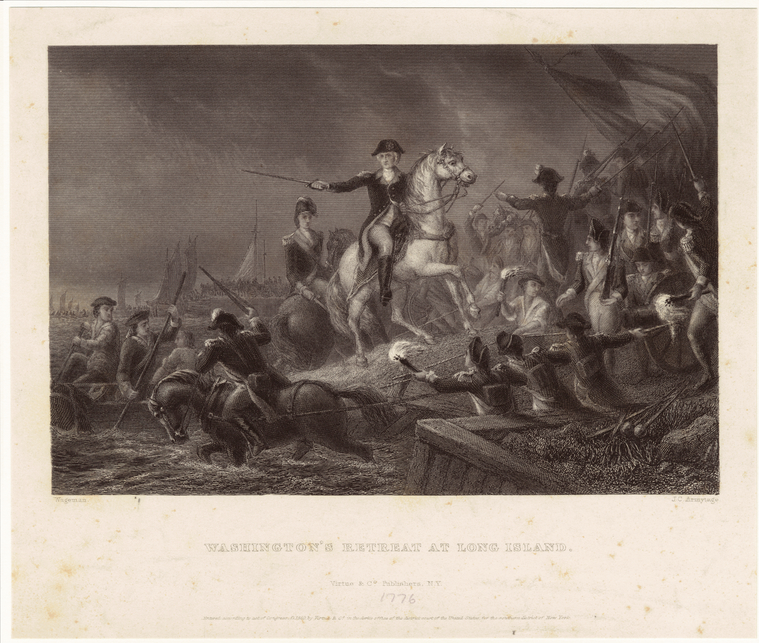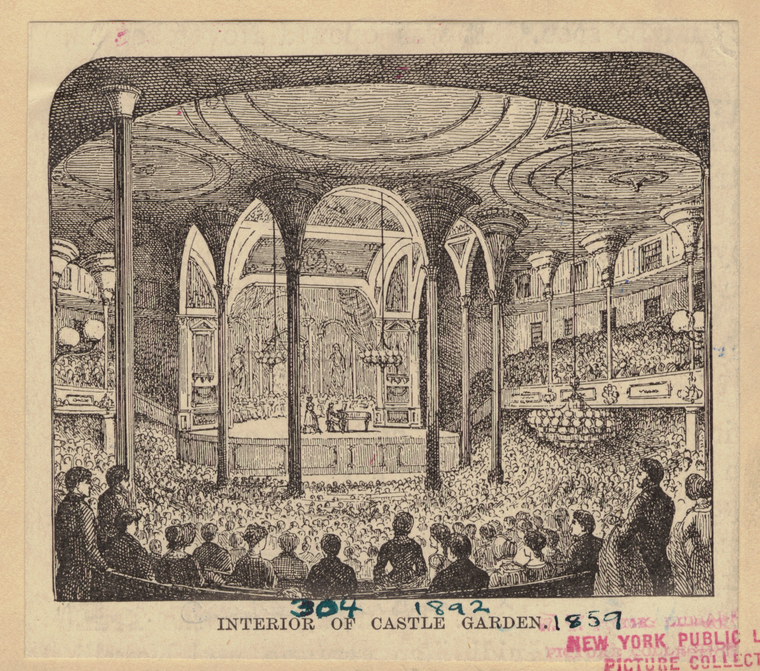ON THE AIR: Music Landmarks in NYC - Yankee Doodle to Jay-Z
Pearl Street

Native/Indigenous
AIR is a Native American and ancient colloquialism for music and voice, as heard upon the earth. Musicians and singers performed at festivals at sacred places like Pearl Street, where shells mounded for centuries, in Lenape tradition, to honor and "give thanks" for the sun, moon, stars, rain, wind and all elements of the air.
New Amsterdam. ca. 1625 - People arrived to the various ceremonies and festivals along the East River shoreline via rafts, canoes and by walking down the main island trail (widened for vehicles in the 1600s to become The Broad Way). Dutch settlers characterized the glimmering coastal shells as "mother of pearl." Immigrant "airs" include Irish or Londonderry Air (Danny Boy) and Air On G String by Johann Sebastian Bach, which was the first Bach piece recorded for use "on the air."
 On Air Players, ca. 1910
On Air Players, ca. 1910
Solstice and Thanksgiving-like celebrations were conducted here. The Lenape expression Anushiik Kiisheelumukweengw (Ah-Nih- Sheek Key – shell –uh – muh-kweng) – means "Thank you Creator!"
Anushiik or Wanisi are Lenape words meaning "thank you."
New Amsterdam 1625–1664
 One Bowling Green
One Bowling Green
"We Gather Together"
With flute, drum, shaker and voice, Native Americans introduced music here for some 12,000 years before Europeans and Africans arrived at this site to construct Fort Amsterdam in 1625. The Dutch Reformed Church (Collegiate Church of NY), built within the fort, contained the marriage and baptismal records (celebratory occasions) of colonial immigrants, free and enslaved. "Wilt heden nu treden (We gather together)" published in Amsterdam in 1626, became America's Thanksgiving anthem in the 20th Century.

One Broadway
"Yankee Doodle"
In 1776, Patriot Gen. George Washington's military headquarters was located here, just north of the cannon battery along the southern coast of Manhattan Island. Revolutionary War musicians in this SPIRIT OF '76 illustration were rendered by artist Archibald Willard from the Marblehead Militia in Massachusetts. In Brooklyn, British forces almost defeated the Americans, however, Gen. Washington avoided defeat by leading 9,000 Patriot soldiers safely across the East River to Manhattan from Brooklyn—

Tillary Street Brooklyn
Just down the riverbank from George Westinghouse Career and Technical Education High School on Tillary Street, attended by Christopher Wallace (The Notorious B.I.G.) Trevor Smith Jr. (Busta Rhymes) Earl Simmons (DMX) and Shawn Carter (Jay Z).
Castle Garden
 Portrait of Frank Johnson, from a Lithograph by Hoffy, 1846, Penn Special Collections
Portrait of Frank Johnson, from a Lithograph by Hoffy, 1846, Penn Special Collections
"Star Spangled Banner"
Bugler, violinist, composer and conductor, Francis "Frank" Johnson performed at Castle Garden, August 22, 1831. "Admission 13½ cents for which refreshments will be furnished," advertised the New York Evening Post. Martinique-born and Philadelphia-based, Johnson performed primarily for aristocratic cotillions like Saratoga Springs and Cape May. With his brass he played military marches.
America's most important "missing musician," proclaimed Harvard musicologist Eileen Southern, who argued that Johnson's absence from historic acclaim was due largely to bigotry within 19th century American media and academia. Johnson regularly performed "Yankee Doodle" and "Star Spangled Banner." In 1837, he performed for Princess (later Queen) Victoria "God Save The Queen" (later fitted by Americans to become "My Country Tis Of Thee." Johnson's assembled band was the first American musical ensemble to travel to England. Johnson was known for his dramatic performance style and creating realistic effects, like speeding trains and "bombs bursting in air."
Also at Castle Garden:
The New York Philharmonic, organized in 1842, premiered Beethoven's Symphony No. 9 at Castle Garden in 1846.
From 1855 to 1892, Castle Garden served as United States emigrant depot, prior to Ellis Island. 11 million people emigrated through the renamed Castle Clinton, including Joseph Pulitzer, Sophie Tucker and Bert Williams.
John Street Theatre

In 1789, a production linking the liberation of "Afric's sable Sons" was applauded by theatre-goers.
Shall Freedom's Sons on others put the chain!
Detested thought! Soon may we hope to see,
Columbia, Europe, Asia, Afric, FREE,
One Genius reigns through all—ETERNAL LIBERTY.
Cotton Exchange
"Dixie," also known As "Wish I Was in Dixie" or "Dixie's Land" or "Land of Cotton" was written in New York City, so claimed its author, Daniel Decatur Emmett. The song was performed in minstrel shows throughout the United States, making Dixie synonymous with the Southern United States and its later Confederacy. The song was played at Jefferson Davis's Confederacy inauguration in 1861. The song was a favorite of President Abraham Lincoln, who had it played at the announcement of General Robert E. Lee's surrender.
The Cotton Exchange was located at 142 Pearl Street.
1 Hanover Square was formerly known as the Cotton Exchange.
Four Corners - Crossroads
135th Street and Lenox Avenue

A century ago, a library, a hospital, a school and a theatre were neighborhood landmarks at 135th Street and Lenox Avenue.
"Harlem is America's Vienna and Rome," said composer, educator and America's once music mentor Leonard Bernstein.
FOUR CORNERS are historic landmarks to the lives and music of neighborhood residents and visitors including Marcus Garvey, Madame C.J. Walker, W.E.B DuBois, Will Marion Cook, Arturo Schomburg and Malcolm X. And CROSSROADS of the 135th Street musicians, ring shouters, spiritual and Gospel singers and composers like James Weldon Johnson's "Left Every Voice and Sing" and Harry T. Burleigh's "Deep River" and the Lenox Avenue stylings of James Reese Europe ("Here Comes My Daddy Now" with the marching 369th Harlem Hell Fighters marching soldiers and band, returning to Harlem after World War I) Scott Joplin, Jelly Roll Morton, W.C. Handy, Mamie Smith, Duke Ellington, George Gershwin, Cab Calloway, Zora Neal Hurston, Savoy Ballroom, Cotton Club, neighborhood Rent and House Parties, May Chinn (a pianist and doctor at Harlem Hospital), Countee Cullen, James Baldwin, Romare Bearden, Harry Belafonte, Jimi Hendrix and Alicia Keyes.
At FOUR CORNERS, SW corner, Adam Clayton Powell,Thomas Waller and Sonny Rollins went to school (PS 89—now PS 175); at SE, Ma Rainey and Mamie Smith performed (Lincoln Theatre—now AME Metropolitan Church—and Alicia Keys made a memorable video appearance in 2005 at the SE corner Pan Pan restaurant); At NE, Dr. MLK Jr, recovered from an assassination attempt in 1958 and Sammy Davis Jr. was born and at NW corner, Langston Hughes is buried. (New York Public Library's Schomburg Center for Research In Black Culture—Hughes's cremated remains are within "The Cosmogram" a lobby memorial, inscribed with Hughes' poem, RIVERS, designed by Houston Conwill.)
In Harlem, said Bernstein, "music is in the air."
"All I know about music is that not many people ever really hear it. And even then, on the rare occasions when something opens within, and the music enters, what we mainly hear, or hear corroborated, are personal, private, vanishing evocations. But the man who creates the music is hearing something else, is dealing with the roar rising from the void and imposing order on it as it hits the air. What is evoked in him, then, is of another order, more terrible because it has no words, and triumphant, too, for that same reason. And his triumph, when he triumphs, is ours."
―James Baldwin, Sonny's Blues

RIVERS, Cosmogram, designed by Houston Conwill, in the lobby of the Langston Hughes auditorium at the Schomburg Center for Research in Black Culture.
Ten New York Songs
- "Empire State Of Mind" - Alicia Keyes and Jay-Z
- "New York State of Mind" - Billy Joel
- "Theme from New York, New York" - Film by Martin Scorsese, sung by Liza Minnelli or Frank Sinatra
- "Take A Walk On The Wild Side" - Lou Reed
- "Living For The City" - Stevie Wonder
- "Bronx" - Kurtis Blow
- "New York, New York" - From the musical On The Town, by Betty Comden, Adolph Green and Leonard Bernstein
- "Stompin' At The Savoy" - Benny Goodman, Andy Razaf, Chick Webb
- "I'll Take Manhattan" - Richard Rodgers and Lorenz Hart
- "Wall Street" - Scott Joplin
Christopher Paul Moore is co-author of The Black New Yorkers: 400 Years of African American History, Senior Researcher of The New York Public Library Schomburg Center for Research in Black Culture and a member of the New York City Landmarks Preservation Commission.
Read E-Books with SimplyE
 With your library card, it's easier than ever to choose from more than 300,000 e-books on SimplyE, The New York Public Library's free e-reader app. Gain access to digital resources for all ages, including e-books, audiobooks, databases, and more.
With your library card, it's easier than ever to choose from more than 300,000 e-books on SimplyE, The New York Public Library's free e-reader app. Gain access to digital resources for all ages, including e-books, audiobooks, databases, and more.
If you don’t have an NYPL library card, New York State residents can apply for a digital card online or through SimplyE (available on the App Store or Google Play).
Need more help? Read our guide to using SimplyE.






Comments
History of the Ear
Submitted by Kathleen Hulser (not verified) on December 7, 2013 - 9:02am
Memory Lane
Submitted by Patrica Whitsett (not verified) on December 10, 2013 - 8:33am